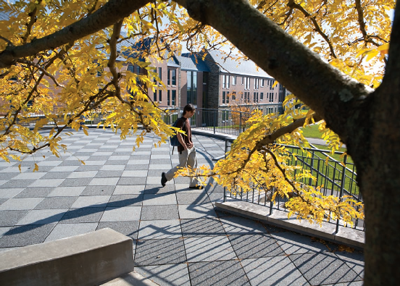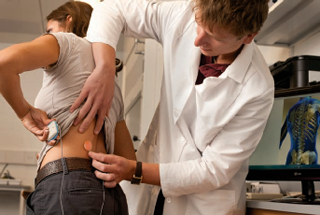Architect Named for Gates Hall ; University Mourns Namesake of New Architecture Building ; Three Campus Libraries to Be Consolidated ; Cornell Tightens Its Belt ; Johnson Museum Director Frank Robinson to Retire ; 2010 Grad Dies in Ithaca ; Arecibo Data Aids in 'Recycled' Pulsar Find ; Husband of Justice Ruth Bader Ginsburg Passes Away ; NSF Funds Bee Database ; 'Electric Sheep' Dream Online

Bang for the buck: As the Class of 2014 gets its bearings on North Campus and the rest of the Hill, they—and their tuition-paying parents—can take comfort in Cornell's status as an academic 'best buy.'
U.S. News & World Report Names Cornell a 'Best Value'
The 2011 U.S. News & World Report rankings of colleges and universities were released in August, and Cornell held steady at its previous spot—fifteen—tied with Brown. But this year, the magazine offered a list of fifty "best value" schools—and Cornell was rated number ten. To calculate the nation's best academic bargains, U.S. News considered such factors as the ratio of quality to price, the percentage of undergrads receiving need-based scholarships and grants, and the percentage of total costs such aid covers. Yale, Harvard, and Princeton topped the list.
Architect Named for Gates Hall
Pritzker Prize-winning architect Thom Mayne and his Los Angeles-based firm, Morphosis, have been selected to design Gates Hall, the future home of the departments of computer science and information science. The $60 million building, named in recognition of the Bill and Melinda Gates Foundation's $25 million gift, will be located across from Barton Hall on the site of the Hoy North parking lot. With 100,000 square feet of space, Gates Hall will have specialized laboratories for cyber security, human-computer interaction, computational sustainability, robotics, computer vision, and more. It's scheduled to open in early 2014.
University Mourns Namesake of New Architecture Building

Paul Milstein, the New York City real estate magnate and namesake of the architecture department's future home, died in August at eighty-eight. The son of a Russian immigrant, Milstein started his career in his father's flooring business and went on to found a real estate empire that included buildings near Lincoln Center and Times Square; at one point, the family controlled some 20 million square feet of office space, 8,000 hotel rooms, and 50,000 apartments. Numerous members of Milstein's family, including son Howard Milstein '73 and daughter Barbara Milstein Zalaznick '76, have attended Cornell. In 2000 his wife, Irma, pledged $10 million toward a new building in his honor. Construction on Paul Milstein Hall, designed by famed architect Rem Koolhaas, began in 2009 and is scheduled to be completed in 2011.
Three Campus Libraries to Be Consolidated
After a review of user habits, the University will consolidate the print collections of its business, hotel, and ILR libraries. While the print holdings will be located at the current ILR library, each school will maintain space for study, electronic resources, and research assistance. Some of the changes will be implemented immediately, while others will be phased in over the next two years. The consolidated library will be overseen by a single director, for whom a search is now under way.
Cornell will also consolidate its entomology collection into Mann Library over the next two years, as the Comstock Hall library is closed; the collection is currently split between the two libraries. Much of its holdings will be digitized during the process. The Comstock library staff will be transferred to Mann, where longer hours will offer increased access.
Cornell Tightens Its Belt
The University aims to save $75 million to $85 million a year by 2015, the administration announced in July. The savings will come from cost cuts proposed by the Initiatives Coordination Office in such areas as facilities, information technology, procurement, human resources, and management. "The goal of these plans is to perform administrative services with fewer resources, with improved results, and with less strain on faculty, students, and staff by creating improved systems and processes," says vice president for human resources Mary Opperman. She adds that though "the implementation plans do impact staff positions," details of potential job eliminations are under review, and there will no across-the-board layoffs. Cornell has announced that it will cut its budget 4.5 percent—or about $71 million—for fiscal year 2011, with total operating expenditures estimated at $1.88 billion.
Johnson Museum Director Frank Robinson to Retire

After two decades at Cornell, Johnson Museum director Frank Robinson will retire at the end of the academic year. In his announcement to the museum's advisory council, he called his time on the Hill "unique, a pure pleasure." Robinson's departure will roughly coincide with the completion of a long-awaited addition to the museum, scheduled to open in fall 2011. Begun in 2009, the $22 million project will add 16,000 square feet for workshops, galleries, a lecture room, and storage. Since the museum opened in 1973, Cornell's art collection has expanded from 10,000 objects to more than 33,000, of which only a fraction is kept on display. The expansion will allow more items to be exhibited and will provide additional space for classes and special programs. The project partly fulfills the Johnson's original architectural plan, which included a northern wing that was eliminated due to financial constraints.

Work in progress: In May, the Medical college held a ceremonial groundbreaking for its planned research building on Manhattan's Upper East Side. Costing upwards of $650 million, the 480,000-square-foot facility will be designed to encourage scientists to come out of their labs and work across disciplines. It will include a floor dedicated to collaborations with Ithaca-based researchers.

Open to interpretation: Ayad Alkadhi's I Am Baghdad XI (2008) is on display at the Johnson Museum this fall. "Tarjama/Translation: Contemporary Art from the Middle East, Central Asia, and Their Diasporas" ends October 3.
2010 Grad Dies in Ithaca
After a difficult year that saw a series of student deaths—due to suicide, accident, and illness—the University lost a recent alumna just weeks after graduation. Twenty-one-year-old Mariel Christie '10 of Clifton Park, New York, died in Ithaca on July 11. A biological sciences major in CALS, Christie worked at the Comstock Entomology Library and the Oxley Equestrian Center. The cause of her death has not been disclosed.
Arecibo Data Aids in 'Recycled' Pulsar Find
Data from Cornell's Arecibo Observatory has led to the discovery of a lone pulsar—a rotating neutron star that emits a beam of electromagnetic radiation— approximately 17,000 light years away. The finding was the first deep-space discovery by Einstein@Home, a research effort that uses donated computing time from home and office machines around the world to analyze astronomical data. According to astronomy professor Jim Cordes, the newly discovered pulsar—which has an unusually low magnetic field—is notable because it is likely "recycled": it once had a companion star that exploded, kicking it free. "No matter what else we find out about it," says Cordes, "this pulsar is bound to be extremely interesting for understanding the basic physics of neutron stars and how they form."
Husband of Justice Ruth Bader Ginsburg Passes Away
Martin Ginsburg '53, husband of Supreme Court Justice Ruth Bader Ginsburg '54, died of cancer in June. He was seventy-eight. A Harvard-educated tax attorney whose high-profile clients included Ross Perot, he also taught tax law at NYU, Columbia, and Georgetown. Ginsburg, who was buried at Arlington National Cemetery, is survived by his wife and two children. As he said at the time of Justice Ginsburg's nomination to the high court: "I have been supportive of my wife since the beginning of time, and she has been supportive of me. It's not sacrifice; it's family." The couple, who met on a blind date at Cornell, celebrated their fifty-sixth anniversary the week before his death.
NSF Funds Bee Database
With a $1.5 million grant from the National Science Foundation, entomologist Bryan Danforth is co-leading a multi-institution project to create a public online database to study declining worldwide bee populations. The database will comprise information gathered from ten bee collections nationwide—including Cornell's, which houses an estimated 250,000 specimens from 3,600 species. The data will assist researchers in studying historical distributions of species, conservation conditions, and risks to pollination. "There is more and more interest in the role that wild bees are playing in crop pollination across the country," Danforth says. Collaborators include the American Museum of Natural History, the USDA, and several University of California campuses.
'Electric Sheep' Dream Online
Alumni interested in the New Student Reading Project can browse an online version of Kroch Library's exhibit on this year's book— Philip K. Dick's Do Androids Dream of Electric Sheep?—and the 1982 Harrison Ford film it inspired, director Ridley Scott's Blade Runner. The exhibit, "Android Dreams: Philip K. Dick and Ridley Scott's Replicant Futures," explores the translation from novel to screen and beyond, including other adaptations of the story such as comic books and the film's "director's cut." The physical exhibit will be on display in Kroch through October 8, while the online version can be viewed at rmc.library.cornell.edu/androids/.

Pain less: Engineering doctoral candidate George Lewis, MS '08, demonstrates his iPod-sized ultrasound device for pain relief. The project, a collaboration with Medical college professor Cary Reid, won second place in the Center for Integration of Medicine and Innovative Technology Primary Health-care Prizes competition. First prize went to grad student Mark Hartman '07, ME '08, who designed a DNA-based test for throat ailments.


